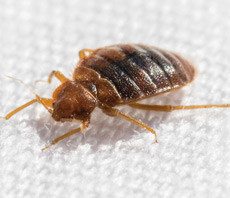 Bed bugs are the pest world’s most elusive insect. They escape into mattress fabric and appear in the nighttime hours to disturb our sleep with welt-inducing bites, only to escape and remain out of sight. Controlling their presence is quite difficult, as many techniques don’t entirely resolve a deeply-rooted infestation. Suggested removal options range from drying your bed sheets 15 different times to throwing out your mattress entirely. Treating bed bugs is as much a headache as their continual biting and sleep interruption.
Bed bugs are the pest world’s most elusive insect. They escape into mattress fabric and appear in the nighttime hours to disturb our sleep with welt-inducing bites, only to escape and remain out of sight. Controlling their presence is quite difficult, as many techniques don’t entirely resolve a deeply-rooted infestation. Suggested removal options range from drying your bed sheets 15 different times to throwing out your mattress entirely. Treating bed bugs is as much a headache as their continual biting and sleep interruption.
Even more troubling is the Climax lectularius’ biological evolution. Ever since bed bugs’ resurgence in the past decade, entomologists have been carefully observing their evolution and have found may bed bugs have developed a resistance to the active ingredient in many market-available insecticides. They produce detoxifying enzymes that counteract the chemical effects found in the most commonly used pesticides. However, for Bed Bug Awareness Week, we examine why chemicals aren’t entirely necessary in treating these blood suckers.
Get A Free Quote
Bed Bug Heat Treatment
A “thermal death point” or “thermal death time” is a specific temperature and exposure duration required to kill a certain bacteria. This is most common in food processing, where destroying microbes on produce is essential for consumption. Much like these microorganisms, bed bugs also possess a thermal death point. When exposed temperatures over 120 degrees Fahrenheit for an extended period of time, the entire population and any surrounding eggs are completely eliminated. Of all the documented bed bug control methods, heat treatment has proven to be the most effective.
Employing a heat treatment program is best for severe infestations and quick elimination, but a few drawbacks and limitations exist with this option. Heat is best used to control the insects’ presence in a centralized location. It’s perfect in removing bed bugs in your master bedroom or hotel suite, but it could get very costly if your bed bug issue is more wide-spread in a building. Another limitation is access to the site of the bed bug infestation. Some structural limitations exist, for example, rooms that are directly adjacent to a concrete foundation or a room significantly larger than the average home. Heating units are also run off of generators, so many pest control companies have height restrictions on the use of their heaters (Wil-Kil does not). If you are situated in a high rise, there may be some companies that can’t physically reach your location with their equipment.
Conventional Applications
Historically, the most common treatment for a pest infestation in your home or commercial building is a pesticide application. The same is true of bed bugs, but, as we mentioned above, certain chemicals may not have an effect on bed bugs today. Even in cases where resistance isn’t a factor, treating bed bugs through insecticide application is not always the most effective solution due to the many limitations.
One limitation to insecticide application is access to the actual bed bugs. Most insecticides that work against bed bugs are contact insecticides, meaning they actually have to touch the bed bugs to eliminate them. If bed bugs are tucked away deep inside a crack, crevice or even in the wall, it’s possible they will be missed by the insecticide. For this reason, conventional applications are only effective through multiple visits, which is another drawback. Where heat can effectively eliminate a bed bug infestation in a few hours with minimal preparation required, pesticide treatments require significant preparation and they need weeks or months to accomplish complete elimination. This means if you are a hotel manager, you have a room out of service for an extended period of time and run the risk that bed bugs move from one room to the next before they are killed.
Proactive Measures
While not the most exciting or flashy, there are proactive measures that can be taken to decrease the risk of a wide-scale infestation and increase the possibility that a problem is caught when you have a few bugs, instead of a few hundred. This is where integrated pest management (IPM) comes into play.
One of the most important “best practices” in an IPM strategy is regular inspections. Where bed bugs are visible and you and/or your staff should be able to see the signs of bed bugs, they are experts at hiding and can be very difficult to find. This is why employing a bed bug sniffing dog is crucial to identifying and subsequently controlling an infestation. Trained canines have been proven to identify bed bugs at all life cycle phases, even having the ability to differentiate between live and dead insects. According to one particular study, dogs trained in recognizing bed bugs can have up to a 97% accuracy rate. Employing a bed bug sniffing dog and using your pest management company to build a plan based on the findings can be a very effective in proactive control.
If you are a homeowner, be leery of second-hand furniture. This is one of the most common ways to transfer bed bugs from place to place. If you are a property manager, have policies in place against second-hand furniture and put controls in place to prevent “dumpster diving.” Finally, there are other “early detection” devices available for bed bugs. Mattress and box spring covers, or “encasements” can be an effective way to protect your mattress. When used properly, bed bugs can’t penetrate the fabrics, so if bed bugs are in your mattress, they will eventually die inside the encasement. If you don’t have bed bugs currently, they can’t get to your mattress through the encasement and bed bugs are much easier to spot. There are also monitoring devices that can be put under your bed or sofa, to capture bed bugs as they start to ascend the bed, giving you an early indication that treatment is needed.

